Since the ancient Maya were the only fully literate civilisation of mesoamerica, it is important that we offer some information on some of the concepts they develop. The following writing will include concepts such as: creation, cosmos (world view), and Religion Lets take a concise look at these concepts.
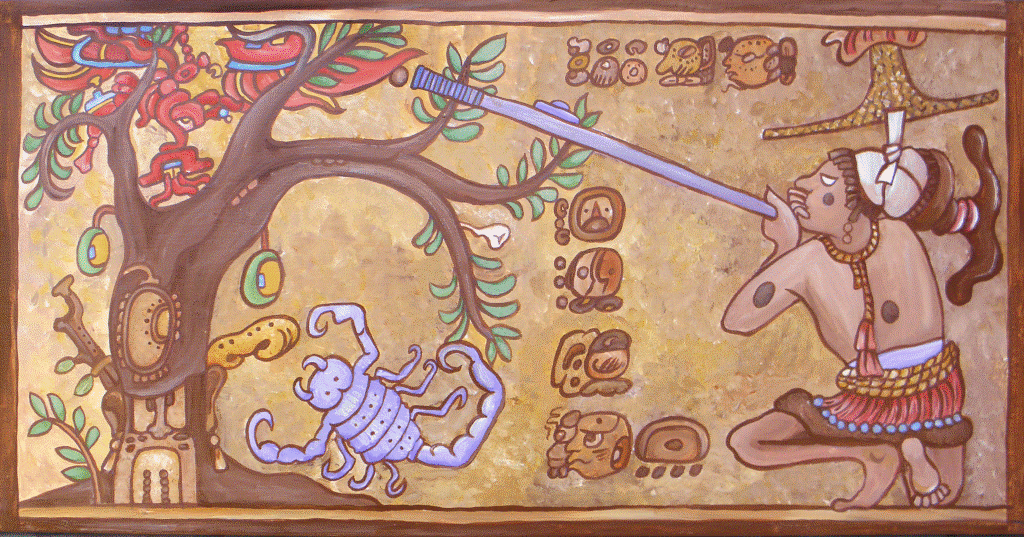
An artist rendition of a scene in the Popol Vuh. Credit:�chevrefeuillescarpediem.blogspot.com
Creation
- The Maya conceived time as cyclical (Life/Universe)
- The Maya tried so hard to syncretize their needs and that of their environment
- They Maya believe that we have now entered the 5th creation of the universe
- They believed that man was created 3 times – 1st of clay, 2nd from wood, and 3rd of corn
- The Popolvuh was a pre classic time system which was written by the Quiche Maya – it was their book of counsel
- There were two Hero Twins, one Ixbalanque and the other Hunahpu; Hunahpu was often linked to the corn god
- The last creation was on December 21st, 2012; before that the last creation was in 3114BC.
- The Maya believed in a system called the sacred round. This round is every 52 years, when a date on their Tzolkin (sacred calendar) calendar meets the same date on the Haab (solar calendar) calendar again.
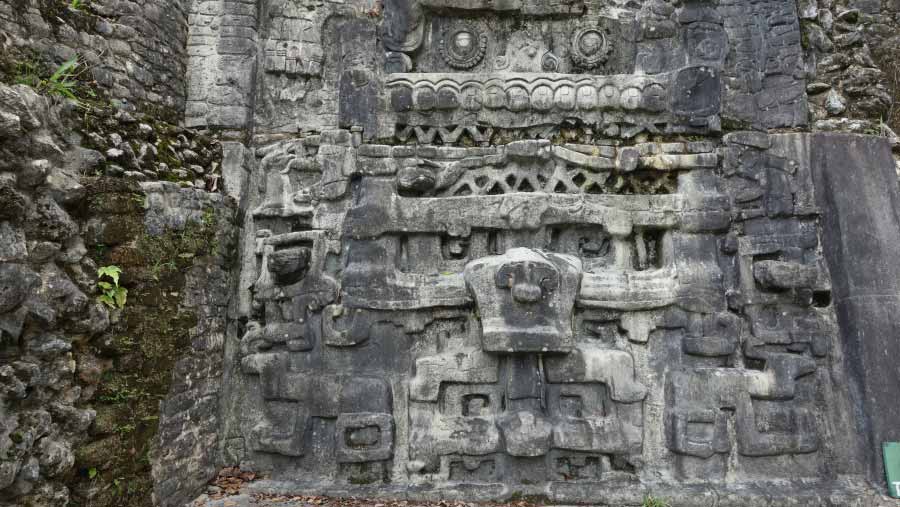
The Water Lily Jaguar/Monster at Caracol, Belize
Cosmology
- The maya believed that the earth was quadripartite
- Each corner was represented with a Bacab (cardinal points)
- In the centre of the earth was the world tree
- Each corner of the earth was associated with a colour: North- white; South – yellow; East – red; West – black; the centre was green
- The vertical division of their world were three: heavens, middle world, underworld
- The heavens had 13 layers
- The underworld had 9 layers (level)
- The Maya believed that the earth floated on a primordial sea on the back of a turtle or a crocodile
- Sometimes one can see art of the corn god coming out of the back nd shell of a turtle

Barton Creek Cave, Cayo Belize. Photo Credit: Maya Popovich of Conch Creative
Religion
- The Maya were polytheistic (they had a pantheon of gods)
- Their supreme god was Hunab Ku
- Itzamna was one of the very powerful gods in the pantheon
- Religion developed in early cultures for and because of things that people could not explain (rain, sun, fire, health/sickness)
- Sun god – Kinich Ahau
- Moon goddess – Ixchel
- Corn god – Yum Kax
- Merchant god – Ek Chua
- The Maya believed that many of these gods were dualistic. They could be good or bad (Rain god – floods; WInd god – storms)
- Underworld gods were known as the Bolontiku. It was called Metnal by the Yucatec Maya and Xibalba by the highland Maya
- Xibablba or Metnal was a place of death and of creation. The source of the human spirit and flesh was in the underworld
- Even in the act of farming the Maya recreated the birth and rebirth in the underworld
- The most sacred activity performed in caves by the Maya were ritual ceremony for agriculture and sustenance

The Pax god on the East frieze at Xunantunich, Belize.
Maya Women
Many people have asked throughout time and everywhere in the Maya world about the role of women in ancient Maya societies. As in all societies, certainly, women were important. The played some vital roles which helped ancient Maya societies thrive. For example:
- They were rulers, as in the case of Lady 6 Sky of Naranjo. They were certainly important for political alliances, such as the one with Calakmul and Caracol through Lady Batz Ek.
- There have been some representation on art panels of women ball ams players in the Tabasco and Campeche, Mexico areas.
- They served in many cases as ritual conductors, especially fertility rituals
- There is no secret that Maya women were some of the best weavers in the world
- There is also no secret that Maya women were some of the best potters in the world

Tattooed Maya Woman. Source: pinterest.com
Ritual�Intoxicants
The ancient Maya Kings, priests and Royalty went into trance every time they participated in rituals on behalf of their people. After all ancestor worship and the marking of time were two major areas of reverence they invested in. Many people have asked what the ancient Maya used to get to that trance plane where they would certainly communicate with their ancestors and gods. The following are a few of the intoxicants they ingested to get to the metaphorical sky of thought:
- Native tobacco, which gave a major nicotine rush
- Trumpet leaves (from the trumpet tree –�Cecropia peltata)
- XIbalba Okox – underground mushroom
- Toad glands (intoxicating sap)
- Ritual enema’s (Balche – fermented corn)

Ritual Enema. Source: mindhacks.com
Maya Subsistence
To survive, the ancient Maya organised what Dr. Jared Diamond of UCLA refers to as the greatest invention in agriculture in a tropical space: slash-and-burn/Swidden/Milpa system. They did not only farm, they also were invested in animal husbandry where they raised turkeys, wild boars, deer, stingless bees, and the dog to name a few animals. They also traded for food stuff that they did not immediately have access.

The ocellated turkey. Source: www.garykramer.net
Extensive and intensive farming were the two most used systems of their agriculture. The former, requires a substantial amount of land (it is important to make known here that this form is still applied to the forests and fields in Central America today). The latter system was organised around raised fields and alluvial valleys�with substantial terracing. Terraces captured sediments as they would flow down hill with rainfall. On these fields the Maya subsided on corn, beans and squash – which was considered the nutrition “trinity” – macal (potato-like tuber), chilis, avocado, tomato, amaranth, jicama, all spice, cilantro, cacao, kinep, mamie apple, yuca (cassava), chaya and cilantro to name a few.
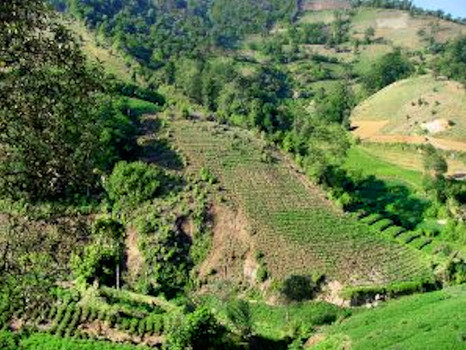
Terraced Maya Fields. Source:�www.examiner.com
Theories For Decline In Central Maya Lowlands
How could a civilisation like the Egyptians, the Phoenicians, the Africans �and the Maya just seemingly disappear. For sure, the people didn’t, they certainly evolved and mixed with other groups, but the great astronomy, the mathematics, the trade, the kings�it blows minds! �For the purpose of this essay the Maya decline will be discussed.
There are two broad-based theories tied to the ancient Maya decline. Those are based on internal factors and the other, based on external factors.
The External Factors
Some scholars originally suggested that there was foreign invasion from the West, the Putun area – on the Western neck of the Yucatan (on the map below, the area closest to the sea in Campeche).
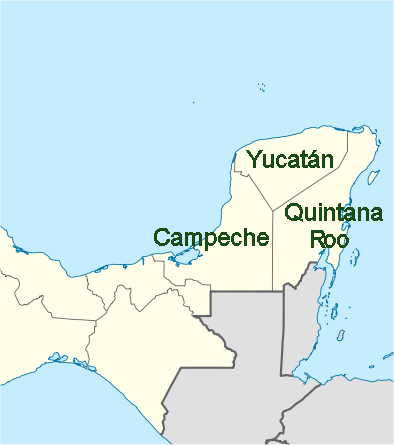
Map of the Maya area. Credit: ilovemexicoblogspot.com
The Putun Maya you see were great sea traders and raiders. As per the usual everywhere in the world, the traders were bilingual and so were the Putun. Some scholars suggested that the Putun invaded the Central Maya Lowlands. Their fine orange pottery was found in every part of the central lowlands, seemingly adding to idea that these Western people would have invaded. However, scholars later recognised that the pottery was based on trade, not take-over.
What could have happened to the central Maya lowlands was a dramatic change in the trade routes which would have had devastating effects on the Maya inland if the trade moved to a strict sea route. Imagine not getting the necessary salt from the coast and you would live at Caracol.

Maya Trade Routes. Credit:�themayaproject.weebly.com
The second broad theory is that of internal factors. The list below suggests what internal factors could have been the reason or reasons the Central Maya Lowlands declined and eventually collapsed.
Internal Factors
- Natural catastrophes: such as hurricanes, earthquakes, volcanic eruptions (it must be noted that volcanic eruptions were more based in the highlands). Diseases such as yellow fever and other epidemics caused by overpopulations and poor nutrient ingestion could have been a factor for the decline. Certainly it affects countries and regions throughout the world today.
- �Social upheaval – or in the language of today – “Central Lowland Spring”. The people rose up against the elite and demanded change and when that change didn’t come they lost their patience and destroyed almost everything that was reflective of the elite.
- Warfare: A great story comes out of Dos Pilas a city state in Peten Guatemala where evidence has been found of violence which occurred in the ancient city of Tikal�and Dos Pilas became the new city refuge of the royalty from Tikal. This warfare was happening throughout the ancient Maya world.
- Ecological problems: can be caused by many things. A. Methods of exploitation (of resources), B. High Population, C. Inability to produce enough of basic health and nutrition requirements, D. Climate change (Yes! It was changing drastically then too!)

Art Fresco Of Violent Attack Of Maya Versus Maya. Credit: www.neatorama.com
Many of the reasons mentioned above on their own could not convince researchers, scientists and anthropologists caused the utter abandonment of the the entire Central Maya Lowland cities. There is just not enough evidence to singularly commit to one factor. However, imagine all the factors coming together in the pressure of a tsunami on the sustainable pillars (economic, social, political and environmental) of these people what mighty devastation this would have been – even for todays societies.

Ecosystem Collapse. Photo Credit: www.mongabay.com
The Maya Conquest Notes
If you use your imagination, this piece of writing can truly come to life! Imagine you live in the tropical forest. Everyone you have ever known was brown. You have never seen a horse – actually, you have never heard that word before!

Spaniards on their horses in America for the first time. Credit:�shelledy.mesa_.k12.co_.us
Then, behind them a ship the size you have never seen before. Yes, the ancient Maya had huge boats but nothing like the Spanish Galleons that came floating to their front door.

Spanish Galleon. Credit:�staugustine.com
The following are dates that represent the movement of the Spanish upon ancient Maya territory during the conquest.
1502: The first contact with Spanish in Bay of Honduras by Columbus on his 4th voyage
1511: Valdivia is hit by a hurricane and 16 people make it to land in the Yucatan Peninsula. They are captured by the Maya but most are sacrificed. Only 2 survive: Francisco de Guerrero and Geronimo Aguilar – they are sold or given to the Maya King Nachan Kan
1514: The small pox epidemic hits Yucatan and thousands of people die, even before the conquest
1515: The epidemic continues. The Maya call it the “mayacimil” (“The easy death”)
1517: Cordova leaves Cuba and starts to explore (It must be noted that Cuba is approximately 60 miles from the Northeastern tip of the Yucatan). He circumnavigates the Yucatan Peninsula and lands in Campeche. The Maya attack and kill most of them!
1518: Grijalva’s expedition – he also circumnavigates the river named after him
1519-1521: Cortez ransoms Aguilar (captive of the Maya) but is unsuccessful with Guerrero as he was the husband of Nachan kan. He goes on to conquer the Aztec
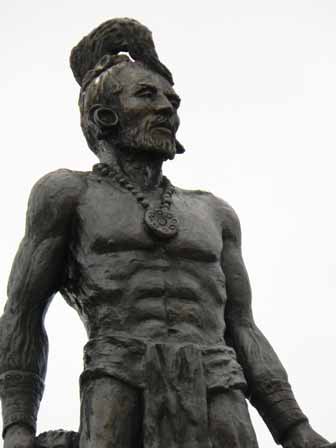
Gonzalo Guerrero “became” Maya
1523-1524: Alvarado conducts conquest of highland Guatemala
1524-1525: Cortez leaves people to conquer Honduras but they wanted to make deal with Spanish government; Cortez then marches to Tayasal (Flores, Peten) after he sacrifices Cautemoc – the last ruler of the Aztec. He then meets Kan Ek at Tayasal
1527-1528: Francisco Montejo (the elder) gets the “go ahead” by Cortez to lead conquest of the Yucatan, but dies before that opportunity. His young son then takes over.
1540-1546: Montejo (Junior) only partially conquers Yucatan – only the Western side. Bacalar was his base. Spanish priests, Juan de Orbita and Fuensalida build churches at Lamanai, Zaczus, and Tipu. From Tipu, via the Mopan river (flows through Benque Viejo town and San Jose Succotz, Western Belize) the enter Lakes in the Peten until the arrive to Lake Peten Itza (The second largest lake in Guatemala within which Flores, the island Capital sits).
1697: Tayasal finally falls to the Spanish

Flores (Tayasal) Peten, Guatemala. Credit:www.pinterest.com
After these dramatic occasions above, most Maya kept on with their lives independently. In the 1800’s the Maya eventually gained immunity to small pox and chicken pox.
1847: The Caste war commences (Yucatan). It was led by the Cocom family (Tribe). As history would have it, they stopped the fight due to their cultural planting season, just before they reach Merida. If they would have continued, perhaps, the Yucatan would have been an independent country. WHo knows!
1869: The Maya attack the Spanish at San Cristobal de las Casas; they also attacked the City of Tzotzil �they were not allowed to be in these cities after dark.

Comandante Marcos, iconic leader of the Zapatista movement. Credit:bbc.com
�1990: The Maya revolted in Chiapas, Mexico – called the Zapatista revolt
One of the greatest achievement of the Maya is their RESILIENCY!

Maya girls from highland Guatemala. Credit: upload.wikimedia.org_.jpg
They are still here with us!!
Olmec In America
The name Olmec translated refers to “dweller in the land of rubber”. They were an American civilisation that certainly may have had a lot of influence on civilisations on the American mainland, including the Maya. The predominant sites that these “rubber people” dominated and gave to history were found in the centre of the Mexican Gulf Coast.
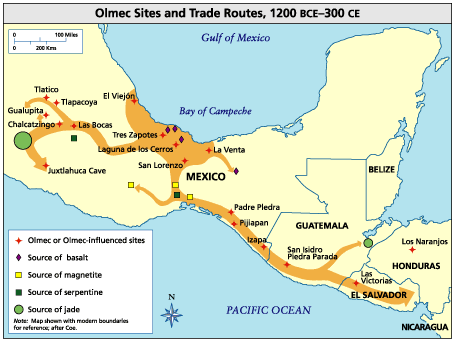
The Olmec Trade Routes. Credit:�www.latinamericanstudies.org
The names of those initial sites were Tes Zapotes, Laguna de los Cerros, San Lorenzo and La Venta which are found in the Mexican provinces of Vera Cruz and Tabasco.
These people are credited for some of the influences on other civilisations around them, including the Maya with inventions such as:
The ballgame, arithmetic, calendar, monumental art, portable art (crocodilian images), motifs (such as: the flaming eyebrow, The U-element, Saint Andrews cross, and the Kan cross)

Olmec Colossal Head. Credit:�www.internetstones.com
In the middle pre classic period people are really organising more. Specialisation starts in many areas such as priests, potters, tool makers and an increase in trade and communication.
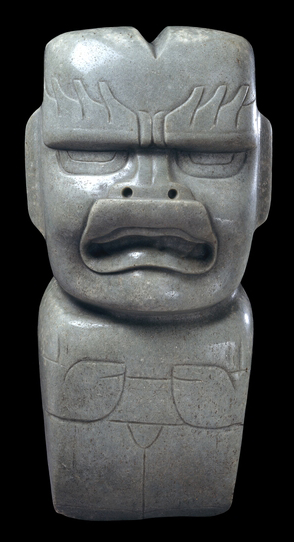
The Olmec Flaming Eyebrow Design On �Jade Piece. Credit:�www.khanacademy.org
The Olmec people are suggested by archaeologists to be the first ‘established” civilisation in America. These people developed in the Olmec heartland in Tabasco and Vera Cruz. The places they organised their entire civilisation were swampy, muggy and tropical.
The Zapotecs were the neighbours of the Olmec and they were developing together from 900BC to 400BC (early pre classic).
Archaeologists found the earliest example of a ball court and rubber ball-making paraphernalia in the year 1920.
San Lorenzo was the Olmec’s first large town (1400 -1300BC to 900BC), then La Venta takes over from 700-400BC. It seems that some group attacked San Lorenzo for this shift to have occurred.
In as far as development, the Olmec made several key developments, as mentioned before, that influenced the Maya civilisation. The Maya developed much of them far more than the original inventors could have imagined. For example, one of the first inscribed monuments which was dated at 31BC �(Stela C) at Tres Zapotes. Certainly the Maya created many more of these with some of the most impressive artistry. None-the-less, the idea of the stelae may have been an Olmec development.

Olmec Mosaic Art Piece At La Venta. Credit:�https-gizzisgoodies.wikispaces.com
Whether the cultural�characteristics and development of the Olmec diffused into the wider Maya area or not, it is appropriate to make note that these people organised themselves to development that eventually most of the Mesoamerican space might seem to adopt, even the great Maya civilisation.
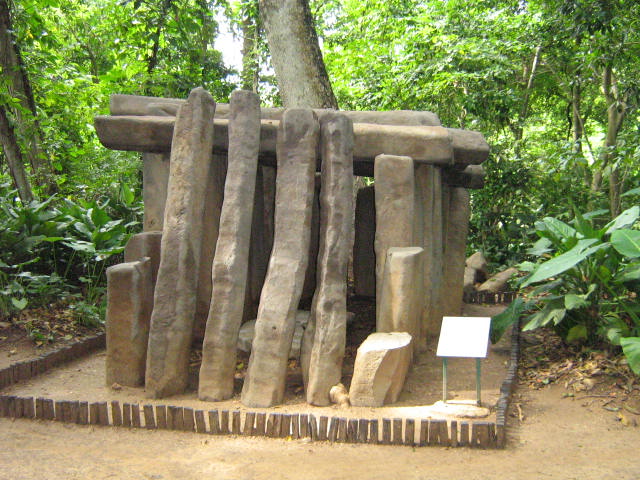
Olmec Tomb. Credit:�upload.wikimedia.org
Multiple Collapses In Mesoamerica
Professor Mark Van Stone, believes that the Creation-Destruction Myth Cycle peculiar to Mesoamerica reflects its history. he thinks that Great Civilisations were utterly destroyed, then rebuilt better than before, but again spiralling down to destruction. To Dr. Van Stone, this became the Cycle of the Suns; a kind of ontogeny recapitulating phylogeny. Dr. Van Stone believes that the destruction of civilisations in Mesoamerica were largely self-inflicted.

Map of Mesoamerican cultures. Credit:�www.thefurtrapper.com
Cultures worldwide suffer rise and fall. But those in Mesoamerica apparently lived in a more fragile environment; when they fell, they fell hard suggests Dr. Van Stone.
He continues by suggesting that, “unlike Rome, Baghdad and other Old World Cities who rebuilt after a collapse, most of the great Mesoamerican capitals were completely abandoned after their respective falls. Middle America swarms with lost cities.

The Lost City of Xunantunich, San Jose Succotz, Belize
The following is a list and time line of cities and places that collapsed in Mesoamerica:
900 BC �– The Early Preclassic Collapse: the major Olmec City of San Lorenzo abandoned. La Venta rose (Gulf Coast)
400 – 300 BC – The Middle Preclassic Collapse snuffed the Olmec Horizon, and �fertilised dozens of Late Formative / Late Preclassic city-states (pan-Mesoamerica)
300 BC – 200 AD – Fluorescence of diverse cultures in Chiapas (Isthmian or Epi Olmec), Oaxaca (Zapotec), Soconusco, Maya area, West Coast (e.g. Colima), Valley of Mexico
100 BC – Cuicuilco buried by a volcanic eruption (southern Valley of Mexico); coincides wight the rise of Teotihuacan (northern valley of Mexico)
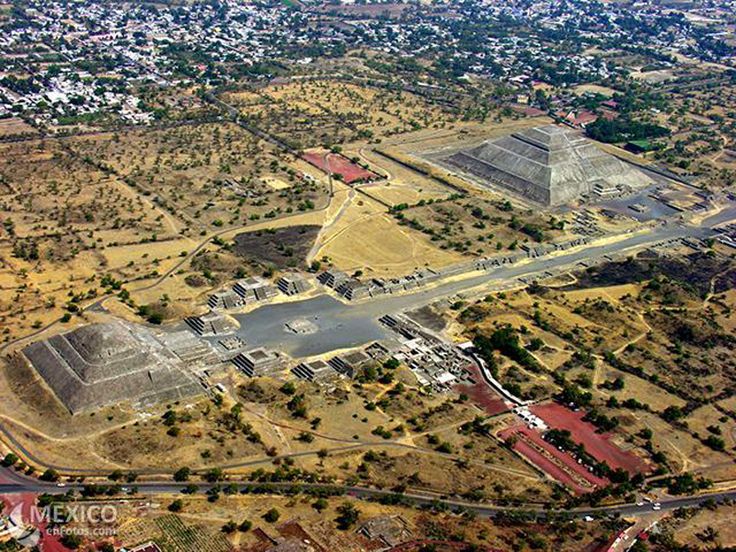
Aerial View Of Teotihucan, Mexican Valley. Credit:�www.pinterest.com
200 AD – Abandonment of great Maya cities in the Mirador Basin marks the boundary between Late Preclassic and Early Classic (Northern Guatemala and neighbourhood)
600/650 AD – the burning of Teotihuacan marks the boundary between Early and Late Classic
600 – 800 AD – The Late Classic was not only a dramatic florescence of Maya and Zapotec Cities, but also the appearance of new civilisations: Remojados and Tajin (Southern Veracruz), Huasteca (Northern Veracruz), Xochicalco (Morelos), Cacaxtla (Puebla)
900 AD – The Classic Collapse: Maya, Zapotec, Vercruz, etc. (pan-Mesoamerica)
1100 – 1250 – The rise of the Cholula and Nahua and Mixteca city-states (Puebla, Oaxaca)

The Ancient City of Tenochtitlan. Credit:�www.planet-mexico.com
1350 – 1450 – The Aztec/Mexica establish an empire in Western Mesoamerica
1500 – 1540 – The conquest: introduce disease; the fall of Tenochtitlan (1521), and then of the rest of the America’s (pan-Mesoamerica)

Monte Alban, Oaxaca, Mexico. Credit:�www.ontheroadin.com
** Ontogeny (the development of an individual organism or anatomical or behavioural feature from the earliest stage to maturity).
** Phylogeny (the evolutionary development and diversification of a species or group of organisms, or of a particular feature of an organism).
Revisiting The Maya End Date 13.0.0.0.0
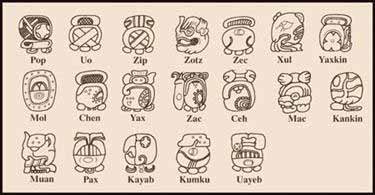
The Haab Calendar Months. Credit:�http://www.gaianxaos.com
We have been receiving many questions lately about the calendar round and the types of calendars the Maya produced. Inescapably too, the end of the Maya calendar of 2012. The world didn’t end, to the grand surprise of many people. The dramatic did make its way through the psyche of may and certainly it was organised to believable – that the world would truly end. It didn’t. What a wonderful thing that we are still here. SO lets revisit this time for the record. The return date of the calendar round to 13.0.0.0.0. Whats the significance?
First, we should recognise what the numbers represented. The numbers represented groups of days. The days would be organised �into 5 distinct grouping which all had a name to represent the amount of days. Reading from right to left, Kin, Uinal, Tun, Katun, Baktun. These were organised as expressed below:
Kin – 1 day
Uinal – 20 days
Tun – 360 days
Katun, 7,200 days
Baktun – 144,000 days
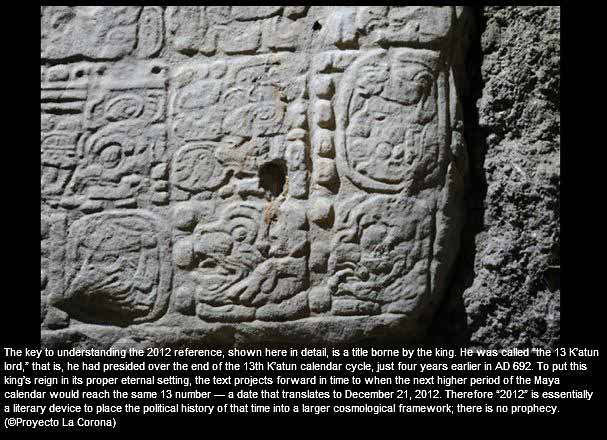
Carved Stela In Guatemala With End Count Date. Credit:�http://in5d.com
The significance of the end date, expressed the most simplest way, is that the Maya Long Count calendar started �not at zero but at 13.0.0.0.0; and in late December 2012 it once again reached the date 13.0.0.0.0 for the first time in 5,125 years, like a clock striking midnight. When the Maya created this phenomenon they may have also realised �or organised that this 2012 date would herald in a new creation.
Second, the earliest known long count calendrical date in Mesoamerica, between 40 and 20 BC come from Chiapa de Crozo, Tres Zapotes and Tak’alik Abaj – the latter is a Maya site, but the other two are Isthmian, the are West of the Maya area. Interestingly, most scholars believe that the long count calendar (Haab) was not a Maya invention.
Third, archaeologist have determined that the Maya calendar may have started on August 11, 3114 BC. �The round went for 5,125 years for the one date “4 Ahau”, the Tzolkin date (260 day sacred calendar) and “8 Cumku”, the Haab �Solar Calendar date (365 days), to come together again since they first started the calendar round in 3114 BC.
Never-the-less, there was much pump and celebration in some parts of the Maya world, while there was utter fear and insecurity in some quarters because of the misconception and misinterpretation of the ‘end date’, and in some quarters – pure “spiritual marketing trickery” about some world-ending catastrophe that truly, the ancient Maya never predicted would occur. Its now 2015. We are still here.
That grand cycle of 5,125 years has started again.

East side of stela C, Quirigua with the mythical creation date of 13 baktuns, 0 katuns, 0 tuns, 0 uinals, 0 kins, 4 Ahau 8 Cumku – August 11, 3114 BC (Source: upload.wikimedia.org)
Palenque And Pakal The Great

King Pacal of Palenque. Source:�upload.wikimedia.org
In 612 began the rule of Muwaan Mat – the same name as an ancestral deity of the site. Muwaan Mat’s identity remains enigmatic, but may have been the mother of, and regent for, Palenque’s most famous king, K’inich Janaab’ Pakal l (“Pacal” or “Great Sun Shield”), who assumed power in 615 at age 12 and ruled until 683. Pakal is one of the best known Mesoamerican kings, famed for his mortuary monument. Yet his reign was not easy. His kingship to Palenque’s established dynasty was, at best, tenuous, and his reign was mired in foreign conflict. Yet Palenque’s “greatest artwork and longest texts emerged as reactions to the defeat and breakdown of its royal line, as new dynasts strove to legitimise and consolidate their power” (Martin and Grube 2000: 155).
For example, the palace was built on an Early Classic foundation, a platform measuring roughly 58 by 79 meters (190 by 259 feet). Pakal’s rooms and courtyards created an administrative residence that dominated the central part of the site. The palace had facilities for ceremonies and receptions, plus amenities like sweat baths and latrines. The design also included architectural innovations to increase the span encountered by the corbeled vault, and also to reduce the weight displaced to the walls, by the use of mansard-style roofs.

Mansard-style roof, Palenque. Source:�learningobjects.wesleyan.edu
Pakal is even more strongly associated with his own funerary monument, the temple of the inscriptions. The design of the sarcophagus and its cover made it possible to ready the tomb, and then, after Pakal’s death, inter the body and slide the cover over it. The, the coffin was connected to the temple atop the pyramid by a “psychoduct” or “spirit tube” – a pipe built into the stairway, by which Pakal’s descendants could contact his spirit. The tomb was plastered shut, and in the anteroom five captives were sacrificed to be Pakal’s companions on his trip to the otherworld. These rites of passage completed, the mourners would ascend the stairs and emerge in the temple of the inscriptions, performing more rituals in sight of the assembled Palenqueans in the plaza below. Such rites, private and public, would assure a safe transition through the dangerous liminal state of passage from the world of the living to the realm of the dead, for Pakal’s spirit and Palenque’s political stability . However, Pakal’s 7th century reign was Palenque’s time of greatness. The dynasty struggled along until around 800, but soon thereafter, was abandoned (Mathews and Schele).
The above is an extraction from the book,�Ancient Mexico And Central America: archaeology and culture history�written by Susan Toby Evans.

Temple of the Inscriptions, Palenque, Mexico. Source:�upload.wikimedia.org
ninebelize.com

